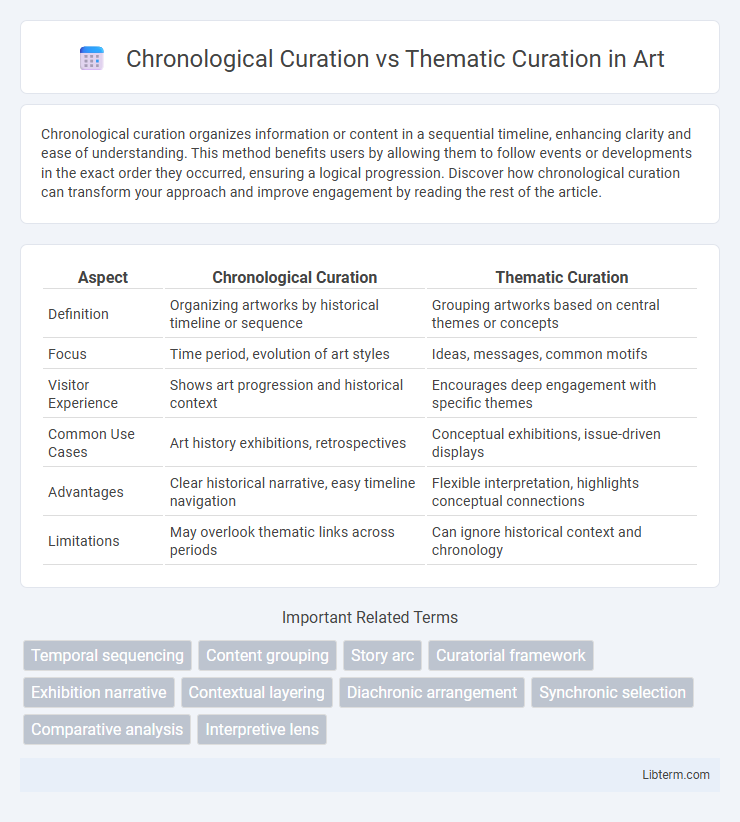Chronological curation organizes information or content in a sequential timeline, enhancing clarity and ease of understanding. This method benefits users by allowing them to follow events or developments in the exact order they occurred, ensuring a logical progression. Discover how chronological curation can transform your approach and improve engagement by reading the rest of the article.
Table of Comparison
| Aspect | Chronological Curation | Thematic Curation |
|---|---|---|
| Definition | Organizing artworks by historical timeline or sequence | Grouping artworks based on central themes or concepts |
| Focus | Time period, evolution of art styles | Ideas, messages, common motifs |
| Visitor Experience | Shows art progression and historical context | Encourages deep engagement with specific themes |
| Common Use Cases | Art history exhibitions, retrospectives | Conceptual exhibitions, issue-driven displays |
| Advantages | Clear historical narrative, easy timeline navigation | Flexible interpretation, highlights conceptual connections |
| Limitations | May overlook thematic links across periods | Can ignore historical context and chronology |
Introduction to Content Curation Methods
Chronological curation organizes content based on the timeline of publication or event occurrence, enabling users to follow developments in a logical sequence. Thematic curation groups content by specific themes, topics, or categories, facilitating deeper exploration of subject matter and enhancing contextual understanding. Both methods serve distinct purposes in digital content strategy, optimizing user engagement and information retention.
Defining Chronological Curation
Chronological curation organizes content or artifacts by their timeline, emphasizing historical progression and context. This method allows audiences to trace developments, transformations, and trends over specific periods, providing clear temporal relationships between items. Chronological curation is particularly effective in exhibitions, archives, and digital platforms where understanding the evolution of subjects is essential for deeper engagement.
Understanding Thematic Curation
Thematic curation organizes content based on central ideas, themes, or concepts, enabling deeper exploration and connection between related pieces. This method enhances user engagement by presenting information in a coherent, meaningful narrative that highlights patterns and insights. Unlike chronological curation, which orders content by time, thematic curation prioritizes relevance and context, making it especially effective for educational and storytelling purposes.
Key Differences Between Chronological and Thematic Curation
Chronological curation organizes content based on the sequence of events, emphasizing the timeline and historical progression, which aids in understanding evolution and context over time. Thematic curation groups content by specific themes or topics, allowing for a deeper exploration of ideas, patterns, or concepts regardless of their temporal order. Key differences include the focus on time in chronological curation versus the focus on subject matter in thematic curation, impacting how audiences interpret and engage with the curated material.
Advantages of Chronological Curation
Chronological curation offers clear advantages by presenting content in a sequential timeline, which helps users easily follow the progression of events or developments over time. This method enhances understanding of cause-and-effect relationships and historical context, making it ideal for educational materials, news archives, and project documentation. Chronological organization also simplifies tracking changes and trends, providing a straightforward narrative flow that supports comprehension and retention.
Benefits of Thematic Curation
Thematic curation enhances user engagement by organizing content based on shared concepts, making information discovery intuitive and contextually relevant. It enables deeper exploration of specific topics, improving retention and understanding through focused narratives. This approach supports personalized experiences and streamlines content navigation, which boosts user satisfaction and content accessibility.
Ideal Use Cases for Each Curation Style
Chronological curation excels in contexts requiring clear historical progression or event sequencing, such as timelines, exhibition narratives, or news archives, where understanding temporal flow is essential. Thematic curation is ideal for grouping content by shared concepts, emotions, or topics, making it effective for educational modules, art showcases, or content marketing where thematic coherence enhances user engagement. Choosing between these styles depends on whether the goal is to highlight development over time or to emphasize interconnected ideas and patterns across a collection.
How to Choose the Right Curation Approach
Choosing the right curation approach depends on the content's purpose and audience engagement goals; chronological curation works best for storytelling or showcasing development over time, while thematic curation highlights patterns, connections, or ideas across different periods. Analyze the target audience's preferences and the content's nature to determine if a sequential timeline or a conceptual grouping will better facilitate understanding and retention. Utilize data on user interaction and feedback to refine curation strategy for maximizing relevance and impact.
Integrating Both Methods for Maximum Impact
Integrating chronological curation with thematic curation enhances content organization by combining temporal flow with topic relevance, creating a richer user experience. Chronological curation ensures a clear timeline and evolution of content, while thematic curation groups related ideas for deeper understanding, boosting engagement and retention. Leveraging both methods simultaneously maximizes content impact by balancing narrative progression and focused exploration, appealing to diverse audience preferences.
Conclusion: Finding Your Optimal Curation Strategy
Choosing between chronological curation and thematic curation depends on your content goals and audience preferences; chronological curation excels in showcasing progression and timelines, while thematic curation highlights connected ideas and patterns. Assess your target audience's needs to determine whether a time-based narrative or a content-focused approach better delivers value and engagement. Combining both strategies selectively can optimize content impact by balancing context with coherence.
Chronological Curation Infographic

 libterm.com
libterm.com